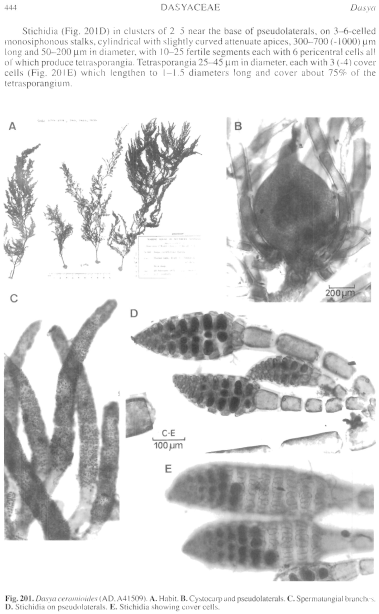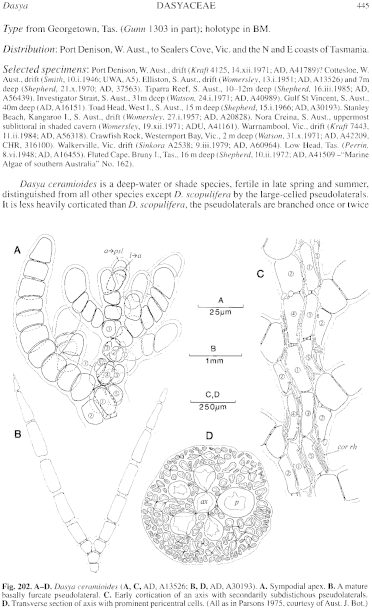|
|
|
|
|
|||||||||||
|
Electronic Flora of South Australia Species Fact Sheet
Phylum Rhodophyta – Order Ceramiales – Family Dasyaceae
Selected citations: J. Agardh 1863: 1187; 1890a: 106. De Toni 1903: 1210. Lucas 1912: 158; 1929a: 23. Lucas & Perrin 1947: 314. Parsons 1975: 591, figs 9C–L, 10, 41A. Shepherd & Womersley 1970: 135. Silva et al. 1996: 435. Sonder 1881: 36. Wilson 1892: 164.
Synonyms
Trichothamnion ceramioides (Harvey) Kützing 1849: 800.
?Dasya pachyclada Harvey 1863, synop.: xxiv. Lucas 1912: 158. Silva et al. 1996: 437. Sonder 1881: 36.
Dasya tingens Harvey & Mueller ex Kützing 1864: 27, pl. 75c, d. (Holotype: Sealers Cove, Victoria. Mueller, MEL, 1005952. Isotypes MEL, 608696, 1005953–1005955, TCD – see Parsons 1975, p. 593).
Dasya hormoclados sensu Harvey 1859: 304 (in part), 1863, synop.: xxiv (in part). Kützing 1864: 27, pls 74, 75a,b. NON J. Agardh 1841: 32. [=Lophocladia hormoclados (J. Agardh) J. Agardh].
Dasya scopulifera sensu Womersley 1950: 181.
Thallus (Fig. 201A) dark brown to red, or pale rose-red, 10–30 (–40) cm high with 1–2 (–5) pyramidal main branches with corticated axes 1–1.5 (–2) mm in diameter. Main axes sympodial (Fig 202A), becoming irregularly radially branched (sometimes pseudolaterals subdistichus) with 2–10 (–15) well developed laterals arising at intervals of 2 mm to 1 (–2) cm, bearing basally branched, attenuate, large celled, pseudolaterals (Fig. 202B). Laterals corticated from close to apices (Fig. 202C), arising from the basal cell of the first branch of the pseudolateral. Adventitious laterals not formed. Holdfast discoid, 2–8 (–14) mm across; on solid substrates. Structure. Pericentral cells 5, remaining prominent (Fig. 202D) in sections at all ages, with slender rhizoidal filaments surrounding the individual pericentral cells and the central cell, later thickly covering the whole surface. Pseudolaterals one per segment, 1.5–3 (–4.6) mm long, simple or with 1–2 basal subdichotomies (Fig. 202B) giving (1–) 2–3 (–4) ultimate branches 8–10 cells long, cells relatively large, 80–230 µm in diameter and L/D 0.3–1 near the base, increasing to (120–) 160–300 µm in diameter and L/D 2–3 (–4) in mid filament, then tapering to 2–3 very small terminal cells in an acute apex, occasionally terminating in an attenuate, pale filament. Adventitious monosiphonous filaments absent. Rhodoplasts discoid to elongate, becoming chained.
Reproduction: Gametophytes dioecious. Procarps borne spirally on successive segments of polysiphonous axes. Carposporophytes with a slight basal fusion cell and ovoid to subspherical carposporangia, in rows of 2–4. Cystocarps (Fig. 201B) sessile, terminal or nearly so on lateral branches, single or rarely paired, urceolate, 550–800 µm in diameter with a prominent neck 0.3–0.7 as long as the cystocarp diameter; pericarp 3–4 cells thick, outer cells relatively large and irregularly shaped. Spermatangial branches (Fig. 201C) in clusters of 2–6 near the base of the pseudolaterals, on monosiphonous stalks, cylindrical to slightly attenuate, 350–750 (–900) µm long and 40–70 (–80) µm in diameter, with 8–10 (–15) fertile segments and often a short, 1–2 (–3)-celled sterile apex.
Stichidia (Fig. 201D) in clusters of 2–5 near the base of pseudolaterals, on 3–6-celled monosiphonous stalks, cylindrical with slightly curved attenuate apices, 300–700 (–1000) µm long and 50–200 p m in diameter, with 10–25 fertile segments each with 6 pericentral cells all of which produce tetrasporangia. Tetrasporangia 25–45 µm in diameter, each with 3 (–4) cover cells (Fig. 201E) which lengthen to 1–1.5 diameters long and cover about 75% of the tetrasporangium.
Type from Georgetown, Tas. (Gunn 1303 in part); holotype in BM.
Distribution: Port Denison, W. Aust., to Sealers Cove, Vic. and the N and E coasts of Tasmania.
Selected specimens: Port Denison, W. Aust., drift (Kraft 4125,14.xii.1971; AD, A41789)? Cottesloe, W. Aust., drift (Smith, 10.i.1946; UWA, A5). Elliston, S. Aust., drift (Womersley, 13.i.1951; AD, A13526) and 7m deep (Shepherd, 21.x.1970; AD, 37563). Tiparra Reef, S. Aust., 10–12m deep (Shepherd, 16.iii.1985; AD, A56439). Investigator Strait, S. Aust., 31 m deep (Watson, 24.i.1971; AD, A40989). Gulf St Vincent, S. Aust., 40m deep (AD, A16151). Toad Head, West I., S. Aust., 15 m deep (Shepherd, 15.i.1966; AD, A30193). Stanley Beach, Kangaroo I., S. Aust., drift (Womersley, 27.i.1957; AD, A20828). Nora Creina, S. Aust., uppermost sublittoral in shaded cavern (Womersley, 19.xii.1971; ADU, A41161). Warrnambool, Vic., drift (Kraft 7443, 11.ii.1984; AD, A56318). Crawfish Rock, Westernport Bay, Vic., 2 m deep (Watson, 31.x.1971; AD, A42209, CHR, 316100). Walkerville, Vic. drift (Sinkora A2538; 9.iii.1979; AD, A60964). Low Head, Tas. (Perrin, 8.vi.1948; AD, A16455). Fluted Cape, Bruny I., Tas., 16 m deep (Shepherd, 10.ii.1972; AD, A41509 –"Marine Algae of southern Australia" No. 162).
Taxonomic notes: rather than 2–3 (–4) times and are only rarely basally polysiphonous, and the stichidia are borne on monosiphonous stalks rather than polysiphonous ones. The laterals of D. scopulifera remain short [5–15 (–30) mm long], whereas those of D. ceramioides are usually several cm long.
D. ceramioides is mainly an eastern species but probably extends to Port Denison, W. Aust., where it overlaps with the strictly western D. scopulifera. The Port Denison specimen is sterile but has the habit of D. ceramioides.
Dasya pachyclada Harvey (1863, synop.: xxiv) is based on a Clifton specimen from W. Aust. (holotype in TCD) and is very similar in habit to the above Port Denison specimen. Though sterile, it is probably a synonym of D.ceramioides.
A detailed account of the structure and stichidia, of D. ceramioides was given by Parsons (1975, p. 596).
References:
AGARDH, J.G. (1841). In historiam algarum symbolae. Linnaea 15, 1–50, 443–457.
AGARDH, J.G. (1863). Species Genera et Ordines Algarum. Vol. 2, Part 3, pp. 787–1291. (Gleerup: Lund.)
AGARDH, J.G. (1890a). Till algernes systematik. Acta Univ. lund. 26(3), 1–125, Plates 1–3.
DE TONI, G.B. (1903). Sylloge Algarum omnium hucusque Cognitarum. Vol. 4. Florideae. Sect. 3, pp. 775–1521 + 1523–1525. (Padua.)
HARVEY, W.H. (1844). Algae of Tasmania. Lond. J. Bot. 3, 428–454.
HARVEY, W.H. (1849). Nereis Australis, pp. 65–124, Plates 26–50. (Reeve: London.)
HARVEY, W.H. (1863). Phycologia Australica. Vol. 5, Plates 241–300, synop., pp. i-lxxiii. (Reeve: London.)
KÜTZING, F.T. (1849). Species Algarum. (Leipzig.)
KÜTZING, F.T. (1864). Tabulae Phycologicae. Vol. 14. (Nordhausen.)
LUCAS, A.H.S. & PERRIN, F. (1947). The Seaweeds of South Australia. Part 2. The Red Seaweeds. (Govt Printer: Adelaide.)
LUCAS, A.H.S. (1912). Supplementary list of the marine algae of Australia. Proc. Linn. Soc. N.S.W. 37, 157–171.
LUCAS, A.H.S. (1929a). The marine algae of Tasmania. Pap. Proc. R. Soc. Tasm. 1928, 6–27.
PARSONS, M.J. (1975). Morphology and taxonomy of the Dasyaceae and Lophothalieae (Rhodomelaceae) of the Rhodophyta. Aust. J. Bot. 23(4), 549–713.
SHEPHERD, S.A. & WOMERSLEY, H.B.S. (1970). The sublittoral ecology of West Island, South Australia: I. Environmental Features and algal ecology. Trans. R. Soc. S. Aust. 94, 105–137, p11.
SILVA, P.C., BASSON, P.W. & MOE, R.L. (1996). Catalogue of the Benthic Marine Algae of the Indian Ocean. (University of California Press: Berkeley, Los Angeles & London.)
SONDER, O.W. (1881). In Mueller, F., Fragmenta Phytographiae Australiae. Supplementum ad volumen undecinum: Algae Australianae hactenus cognitae, pp. 1–42, 105–107. (Melbourne.)
WILSON, J.B. (1892). Catalogue of algae collected at or near Port Phillip Heads and Western Port. Proc. R. Soc. Vict. 4, 157–190.
WOMERSLEY, H.B.S. (1950). The marine algae of Kangaroo Island. III. List of Species 1. Trans. R. Soc. S. Aust. 73, 137–197.
The Marine Benthic Flora of Southern Australia Part IIIC complete list of references.
Publication:
Womersley, H.B.S. (24 December, 1998)
The Marine Benthic Flora of Southern Australia
Rhodophyta. Part IIIC. Ceramiales – Ceramiaceae, Dasyaceae
©State Herbarium of South Australia, Government of South Australia
Illustrations in Womersley Part IIIA, 1998: FIGS 201, 202 A–D.

Figure 201 enlarge
Fig. 201. Dasya ceramioides (AD, A41509). A. Habit. B. Cystocarp and pseudolaterals. C. Spermatangial branches. D. Stichidia on pseudolaterals. E. Stichidia showing cover cells.

Figure 202 enlarge
Fig. 202. A–D. Dasya ceramioides (A, C, AD, A13526; B, D, AD, A30193). A. Sympodial apex. B. A mature basally furcate pseudolateral. C. Early cortication of an axis with secondarily subdistichous pseudolaterals. D. Transverse section of axis with prominent pericentral cells. (All as in Parsons 1975, courtesy of Aust. J. Bot.)

|
Email Contact: State Herbarium of South Australia |

|